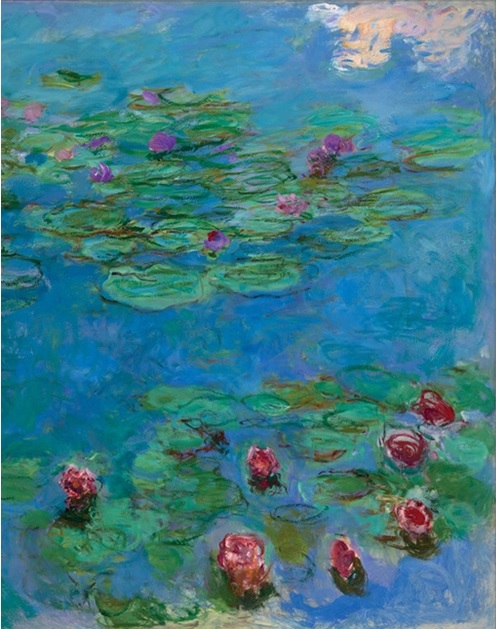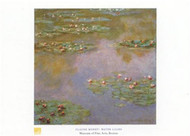Display the Spirit of Impressionism with a Monet Water Lilies Poster
Jun 10th 2022
A well-known fact amongst art enthusiasts and artists, but something that might come as a surprise to some, is that Claude Monet’s “Water Lilies” is not a single painting, but a collection of about 250 individual paintings created by the Impressionist artist during a period from 1897 until his death in 1926.
Monet’s “Water Lilies,” being such a broad series completed over more than two decades of time, offer a unique perspective that is not limited to the passage of time in the natural world as a subject matter, but also to the development of the man himself, the individual artist and his craft.
It so happened that one day, in the late 1800s, Claude Monet was riding through the northern French countryside. As he passed through the small village of Giverny in Normandy, it is said that he was instantly captivated by the beauty of the scene.
Monet set about to rent a house in the village and in 1883 moved his family there. He wasted little time in establishing a home and filling the grounds with ornamental plants, fruit trees, flowers, and other horticultural delights.
As a project integral to his domestic pursuits, Monet diverted a portion of a local river to provide irrigation to his greenery. He brought in a variety of water lilies from abroad and populated the low, wet areas and a pond with them. These became the central subject matter of many of his famous “Water Lilies” paintings.
An interesting if little-known fact about this series of historical events is that his neighbors were in no way pleased with his actions. They feared that the lilies, not being local natives, would adversely affect the local water supply or the ecosystem in general. Whatever their specific grievances, the town council was adamant that Monet remove the water lilies from his grounds.
Needless to say, he did not comply with their demands. By 1899, he had completed his water gardens with the addition of a Japanese-style bridge that would become the focus of many of his Water Lilies paintings, primarily some of the earlier works.

Beginning 1897, Monet spent a greater deal of his artistic focus capturing the life and essence of his water lilies in the eponymous collection that bears their name. The spirit of the collection embodies Impressionism as a school of artistic discipline.
The collection as a whole typifies the elements of Impressionism. In them, Monet has captured the essence of moments in time, still outdoor scenes, accurately depicted in subtle yet, true-to-life colors. But the execution is, like in so many Impressionistic pieces, somewhat minimal. Visible brushstrokes and the suggestion of the subject matter, rather than a realistic depiction of them, seem to overarch and suffuse the collection.
It is interesting to quite note a few things that may be said to be interrelated. For one thing, in many of his Water Lilies, Monet places a great emphasis on capturing the light and life of the surface of the water. In many of them, elements of earth and sky are notoriously absent or present only as reflections in the water. In such scenes, the blue of sky and water become one, with only the water lilies themselves to serve as the sole concrete punctuation between which is “real” and which is “reflection.”
In one sense, it is somewhat surreal how Monet creates a window into perception, allowing the observer to absorb and interpret reflections of true elements through the water’s surface instead of depictions of the elements themselves.
True to the methodologies of Impressionistic painters, Monet’s Water Lilies are diffuse - almost watery looking, which is fitting because they are, after all, depictions of aquatic scenes.
Monet continued his work on Water Lilies as the Great War upended life across continental Europe as well as around the globe. Contemporary English poets like Thomas Hardy spoke of hearing the firing across the channel. It is doubtless, then, that on days at work in and around his home, the artist Monet could hear the artillery sounding, mere miles from where he was hard at work creating scenes of life.
It is also interesting to note that in the later years of Monet’s life, he started to develop cataracts. Some of the later entries into this collection betray the use of a reduced palette and have increasingly amorphous elements. Indeed, in select entries, such as Money’s 1926 “Water Lilies Evening Panel,” noticeable, concrete elements are entirely impossible to discern.
It is entirely possible that this effect was not completely intentional, but a result of the deterioration of the artist’s eyesight. In that sense, the collection, “Water Lilies,” is not only artistically beautiful but artistically biographical.

And considering the fact that Monet’s work on the collection consumed the latter 29 years of his life, the collection truly is a reflection of the artist’s life, at least the latter portion.
The significance of this contribution to the world of art cannot be understated. As a corpus, Water Lilies did perhaps more for the advancement (and acceptance of) both Impressionism and Abstract Art than any other. Monet’s increasing reliance on vivid colors rather than realistic forms, as either his eyesight deteriorated or his creative inspiration flourished, (or both) made sure of that. Of course, this can be debated. But the popularity of the collection, which continues in strength to this day, is a testament to that.
Nearly 100 years after the final entries in the collection were completed, all living memory of such times in history has faded. But Monet’s art lives on in an immortal medium, a somber, and beautiful, reminder that while life persists, it defies destruction, war, and fading health, endeavoring endlessly to capture the spirit of inspiration, and of course, blaze new trails.
Breathe Light, Life, and Color into Your Home with a Monet Water Lilies Poster
Unfortunately, given the fact that Monet’s Water Lilies constitute a priceless contribution to the history of art, we can’t bring those originals into our homes.
But you can invest in a high-quality Monet Water Lilies poster from our online museum gift shop, and that’s as close to the real thing as you’re going to get!
Take a look through our collection of Monet Water Lilies poster and prints, for a reasonable price you can have one of your own and add something beautiful to your home - and you can’t put a price on that.

